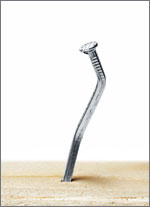Yep. It’s true. Writers may, unfortunately, use a dash when they are in a rush, and don’t have, or don’t take, the time to complete a thought. In fact, one dictionary definition for “dash” is “move with haste; rush….” While the writer may suppose that the reader will complete his or her thought, or will “know what I mean,” this supposition can be dangerous territory.
The reader may very well complete the writer’s thought – with thoughts of his or her own – and totally negate whatever point the writer had hoped to make. Or maybe, and probably more likely, skip along, giving that incomplete or unsupported nascent idea no recognition or thought at all.
The dash is an interruption of your sentence’s smooth flow. That’s why it’s often used for emphasis – because its interruption causes your reader to stop and think, even for that split millisecond. But use dashes economically; too many interruptions can be confusing, and defeat your purpose for using them.
The dash can work in two areas: clarity, and style. As you saw above, not all sources agree on what the dash should look like, and not all keyboards are the same. Writing is a visual art. I prefer the space-hyphen-space (the final one above), but you may choose whichever “looks right” to you. Just remember (1) to be consistent; and (2) to avoid over-use in your writing – more like pepper than salt!
Now: As for the hyphen. Here’s where we have some definite grammar rules, along with some indefinite authoritative differences of opinion.
The dash and the hyphen each have a different job. The dash is often used to “split” or separate, or to emphasize large pieces of a sentence. The hyphen is more of a connector, or disconnector of individual words, or word parts.
Most students learn that when a word must be broken at the end of a line, a hyphen goes at the end of the nearest syllable, or “word bit.” We probably learned that some words are always hyphenated, some never, and with some, it depends. “Look it up,” we may have been told. Here are a few guidelines to make it a bit easier, and if you’re not sure… Well, you know: “Look it up!”
You will want to use hyphens:
• When two words come before the word they are describing, and one or the other is not a stand-alone word, e.g.,
My red-haired sister and I went swimming.
Don’t miss this last-chance opportunity.
• But generally not when those words come after, e.g.,
My sister has red hair.
This opportunity provides your last chance.
• And not when each of the two words is a stand-alone word, e.g.
Augusta was a cranky old lady.
He is a pleasant young man.
• For some terms describing members of a family, e.g.,
mother-in-law; son-in-law
• For fractions, e.g.,
two-thirds; three-quarters
• When the dictionary always spells it with a hyphen
• When using self or quasi, e.g.,
self-awareness; quasi-legal
You must use a hyphen:
• With ex (meaning former), e.g.,
ex-president; ex-representative
• When you add a beginning or an ending to a word that is capitalized, e.g.,
Whitman-like; anti-American
All in the family:
• Use hyphens for ex-spouse; sister-in-law; and great-uncle.
• Do not use a hyphen for stepdaughter; half sister; or grandfather
These are the most common hyphenated and non-hyphenated words. But then there are those other, less-common words, the exceptions, and the surprises, where you cross your fingers, open the dictionary, and hope you get it right!
Bring Gail to your workplace for an onsite workshop, coaching, or consulting. Or to work with your team to complete a writing project.

 [
[